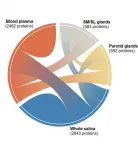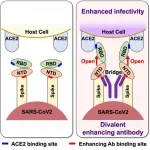(Press-News.org) BUFFALO, N.Y. - To improve the development of new saliva-based diagnostic tests and personalized medicine, the National Institute of Dental and Craniofacial Research (NIDCR) has supported the development of the Human Salivary Proteome Wiki, the first public platform that catalogs and curates data on each of the thousands of proteins within our saliva.
Detailed in an article published on Tuesday, May 25 in the Journal of Dental Research, the wiki provides researchers and clinicians with rich, unbiased evidence from multiple independent studies to help explore the dynamic and complex nature of saliva, as well as analytical tools to search for data by tissue type, disease and more.
"This community-based data and knowledge base will pave the way to harness the full potential of the salivary proteome for diagnosis, risk prediction, and therapy for oral and systemic diseases, and increase preparedness for future emerging diseases and pandemics," says Stefan Ruhl, DDS, PhD, lead investigator of the study, curator of the Human Salivary Proteome Wiki, and professor of oral biology in the University at Buffalo School of Dental Medicine.
Saliva facilitates digestion, taste, swallowing and speech, and serves as the first line of defense against pathogens in the mouth, shielding the body from harmful microbes. Saliva's role in immune responses, as well as the ease with which it may be collected as a fluid sample, make it a desirable tool in precision medicine and noninvasive diagnostics. During the COVID-19 pandemic, it was widely used to detect the virus and track the body's immune response.
A challenge in saliva's study, however, is the high level of variability in the thousands of salivary proteins. Therefore, normal ranges for the composition of saliva need to be established to define the status of health, says Ruhl, who in 2020, co-authored research on how saliva is made, pinpointing the origins of proteins in human saliva back to its sources.
"Saliva has become an attractive body fluid for on-site, remote and real-time monitoring of oral and systemic health. The scientific community needs a saliva-centered information platform that keeps pace with the rapid accumulation of new data and knowledge," says William Lau, PhD, of the National Institutes of Health (NIH) and first author of the study.
"The Human Salivary Proteome Wiki will improve salivary sciences, saliva-based diagnostics, precision medicine and dentistry, and ultimately facilitate personalized treatment for both oral and systemic diseases," says Preethi Chander, PhD, program director of the NIDCR Salivary Biology and Immunology Program.
Modernized to 'harness the full potential of the salivary proteome'
Funded by NIDCR and developed in collaboration with the NIH Center for Information Technology, the Human Salivary Proteome Wiki was released in 2019 as a user-friendly public database to provide rich analytical, curation, and annotation tools for the biomedical research community.
The database compiles information and research on the salivary proteome, genome, transcriptome (types and levels of mRNA expressed in salivary gland tissue), and glycome (array of sugars attached to salivary glycoproteins).
Users may submit proposals to add, and remove or modify data to an interdisciplinary team of curators who ensure information is accurate and supported by sound scientific evidence. Annotations are also credited to the researchers and clinicians who submit them to the wiki, helping drive references to critical research.
The researchers will also host a series of activities that bring contributors together to inspire novel ideas and foster cross-discipline collaborations.
INFORMATION:
Other investigators and curators include Markus Hardt, PhD, mass spectrometry core leader at The Forsyth Institute; Yanhui Zhang, PhD, associate professor at The University of Tennessee Health Science Center; and Marcelo Freire, DDS, PhD, associate professor at the J. Craig Venter Institute.
New effective compounds, which can be endogenous donors of a signaling molecule - hydrogen sulfide in the body, were synthesized by SUSU scientists. Due to this property, the obtained compounds are potential drugs with a cancer-preventing effect. The research work was published in the Russian Chemical Bulletin (Q3).
Organosulfur compounds with anticancer, antibacterial, and antirheumatic properties have been studied for some years by scientists from South Ural State University and N.D. Zelinsky Institute of Organic Chemistry, Russian Academy of Sciences. In the latest study, they attempted to search for new derivatives of 1,2-dithiol-3-thiones - compounds with various ...
Scientists from the UK's University of Bath explore racemases - an important type of enzyme that is linked to certain cancers and other life-threatening diseases while also being critical to cell function - in a paper published in the prestigious journal Chemical Society Reviews. The scientists also propose new strategies for finding drugs that neutralise these enzymes.
Many racemases and epimerases perform vital roles in human and animal cells, and in disease-causing organisms. They facilitate proper nerve function, the degradation of toxic substances, the formation of bacterial cell walls and the conversion of certain drugs into their active ...
Alzheimer's disease is the main cause of dementia and current therapeutic strategies cannot prevent, slow down or cure the pathology. The disease is characterized by memory loss, caused by the degeneration and death of neuronal cells in several regions of the brain, including the hippocampus, which is where memories are initially formed. Researchers from the Netherlands Institute for Neuroscience (NIN) have identified a small molecule that can be used to rejuvenate the brain and counteract the memory loss.
New cells in old brains
The presence of adult-born cells in the hippocampus ...
A research group from Osaka University led by Professor Hisashi Arase and consisting of researchers from the Research Institute for Microbial Diseases, the Institute for Protein Research, the Immunology Frontier Research Center, the Center for Infectious Diseases, and the Graduate School of Medicine has discovered for the first time that both neutralizing antibodies that protect against infection as well as infection-enhancing antibodies that increase infectivity are produced after infection with SARS-CoV-2 by analyzing antibodies derived from COVID-19 patients.
Antibodies against the receptor binding site (RBD) of the SARS-CoV-2 spike protein play an important function as ...
UNIVERSITY PARK, Pa. -- A new map of dark matter in the local universe reveals several previously undiscovered filamentary structures connecting galaxies. The map, developed using machine learning by an international team including a Penn State astrophysicist, could enable studies about the nature of dark matter as well as about the history and future of our local universe.
Dark matter is an elusive substance that makes up 80% of the universe. It also provides the skeleton for what cosmologists call the cosmic web, the large-scale structure of the universe ...
WASHINGTON (May 25, 2021)--A new report summarizes the findings from a national survey of frontline health care workers during the early days of the COVID-19 pandemic, finding that many reported unsafe working conditions and retaliation for voicing their concerns to employers. The survey, launched in May 2020 by staff and student researchers at the George Washington University, provides a snapshot of the experiences of frontline health care workers providing care for millions of Americans during the pandemic.
"This survey gives a voice to US health care workers who have been on the frontlines ...
Photos and Map
The Paleocene-Eocene Thermal Maximum, or PETM, was a short interval of highly elevated global temperatures 56 million years ago that is frequently described as the best ancient analog for present-day climate warming.
Fish are among the organisms thought to be most sensitive to warming climates, and tropical sea-surface temperatures during the PETM likely approached temperatures that are lethal to some modern marine fish species, according to some estimates.
But newly discovered fish fossils from an eastern Egyptian desert site show that marine fishes thrived in at least ...
A study by Monash University and Alfred Health found a 70 per cent reduction in one type of human papillomavirus (HPV) in gay and bisexual men after the implementation of the school-based HPV vaccination program.
The HYPER2 study, published in The Lancet Infectious Diseases, and led by Associate Professor Eric Chow, found there was a significant reduction in all four vaccine-preventable genotypes in gay/bisexual men aged 16-20 years following the introduction of the vaccine for boys in 2013.
Australia is one of the first and few countries that have both boys and girls vaccination programs for ...
It is said that 10 to 15% of the world's agricultural production loss is caused by diseases, which is equivalent of the food for about 500 million people. And since 70-80% of this plant disease is caused by filamentous fungi, protecting crops from filamentous fungi is an important issue in effectively feeding the world population. In order for pathogenic fungi to infect plants, they must break through the epidermal cells of the plant and invade the interior. In other words, plant epidermal cells act as the first barrier to stop the attack of pathogenic fungi in the environment. So what kind of defense functions do ...
In the last year, one thing has become clear: we cannot live life without risk. In fact, every part of our daily routines became subject to analysis: How risky is the action and is its value worth the potential cost?
Risk analysis, though seemingly more ever-present in our thoughts today, has always been a part of how we operate and how the systems around us work. As new pressures, such as climate change, deepen, the accuracy and reliability of risk analysis models regarding issues as basic as the cleanliness of our drinking water have become more important than ever.
USC ...




